英语四六级段落信息匹配题技巧
- 格式:doc
- 大小:211.00 KB
- 文档页数:9
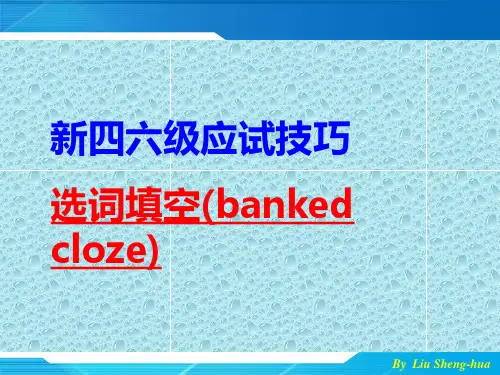
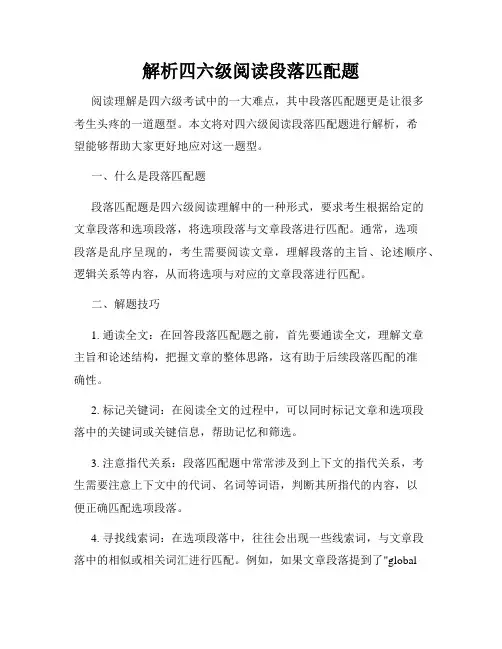
解析四六级阅读段落匹配题阅读理解是四六级考试中的一大难点,其中段落匹配题更是让很多考生头疼的一道题型。
本文将对四六级阅读段落匹配题进行解析,希望能够帮助大家更好地应对这一题型。
一、什么是段落匹配题段落匹配题是四六级阅读理解中的一种形式,要求考生根据给定的文章段落和选项段落,将选项段落与文章段落进行匹配。
通常,选项段落是乱序呈现的,考生需要阅读文章,理解段落的主旨、论述顺序、逻辑关系等内容,从而将选项与对应的文章段落进行匹配。
二、解题技巧1. 通读全文:在回答段落匹配题之前,首先要通读全文,理解文章主旨和论述结构,把握文章的整体思路,这有助于后续段落匹配的准确性。
2. 标记关键词:在阅读全文的过程中,可以同时标记文章和选项段落中的关键词或关键信息,帮助记忆和筛选。
3. 注意指代关系:段落匹配题中常常涉及到上下文的指代关系,考生需要注意上下文中的代词、名词等词语,判断其所指代的内容,以便正确匹配选项段落。
4. 寻找线索词:在选项段落中,往往会出现一些线索词,与文章段落中的相似或相关词汇进行匹配。
例如,如果文章段落提到了"globalwarming",而选项段落中出现了"climate change",那么很可能它们是相互匹配的。
5. 分析逻辑关系:段落匹配题中,选项段落需要与文章段落之间具有合理的逻辑关系,考生可以分析选项段落的论述顺序、论证方式、转折关系等,与文章段落进行对比,找出逻辑上的匹配关系。
6. 排除干扰项:有些选项段落可能会与文章段落有些许关联,但并不完全匹配。
在解答题目时,要学会排除这些干扰项,将注意力集中在与文章段落最相关的选项上。
三、实践演练下面通过一道例题来进一步说明解析四六级阅读段落匹配题的方法:文章段落:(1) The negative effects of climate change are already being seen around the world. (2) Rising temperatures are melting polar ice caps, leading to the rise of sea levels. (3) Extreme weather events, such as hurricanes and droughts, are becoming more frequent and severe. (4) Plant and animal species are being threatened with extinction. (5) Additionally, climate change is having a significant impact on agriculture, with changes in temperature and precipitation affecting crop yields.选项段落:A. Climate change is causing problems for farmers.B. Rising sea levels are a direct result of climate change.C. The impacts of climate change on wildlife are devastating.D. The frequency and severity of extreme weather events are increasing.E. The effects of climate change on the environment are becoming more evident.根据解题技巧,我们来进行分析:1. 首先,我们可以将选项中涉及到的关键词进行标记:climate change(气候变化)、rising sea levels(上升的海平面)、extreme weather events(极端天气事件)、wildlife(野生动植物)、agriculture (农业)。
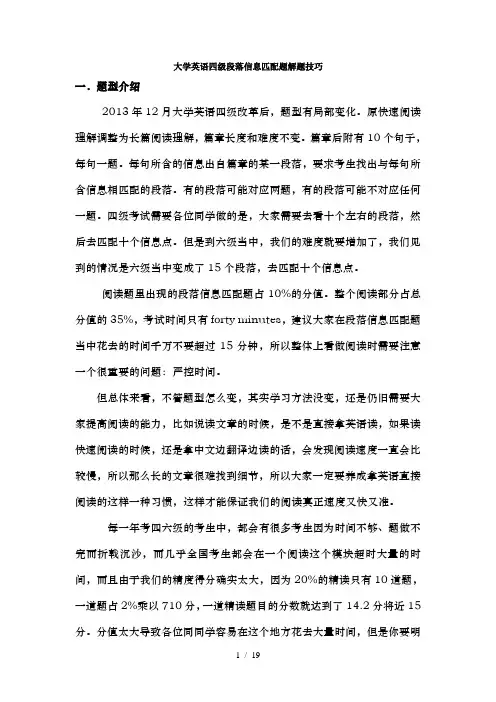
大学英语四级段落信息匹配题解题技巧一.题型介绍2013年12月大学英语四级改革后,题型有局部变化。
原快速阅读理解调整为长篇阅读理解,篇章长度和难度不变。
篇章后附有10个句子,每句一题。
每句所含的信息出自篇章的某一段落,要求考生找出与每句所含信息相匹配的段落。
有的段落可能对应两题,有的段落可能不对应任何一题。
四级考试需要各位同学做的是,大家需要去看十个左右的段落,然后去匹配十个信息点。
但是到六级当中,我们的难度就要增加了,我们见到的情况是六级当中变成了15个段落,去匹配十个信息点。
阅读题里出现的段落信息匹配题占10%的分值。
整个阅读部分占总分值的35%,考试时间只有forty minutes,建议大家在段落信息匹配题当中花去的时间千万不要超过15分钟,所以整体上看做阅读时需要注意一个很重要的问题:严控时间。
但总体来看,不管题型怎么变,其实学习方法没变,还是仍旧需要大家提高阅读的能力,比如说读文章的时候,是不是直接拿英语读,如果读快速阅读的时候,还是拿中文边翻译边读的话,会发现阅读速度一直会比较慢,所以那么长的文章很难找到细节,所以大家一定要养成拿英语直接阅读的这样一种习惯,这样才能保证我们的阅读真正速度又快又准。
每一年考四六级的考生中,都会有很多考生因为时间不够、题做不完而折戟沉沙,而几乎全国考生都会在一个阅读这个模块超时大量的时间,而且由于我们的精度得分确实太大,因为20%的精读只有10道题,一道题占2%乘以710分,一道精读题目的分数就达到了14.2分将近15分。
分值太大导致各位同同学容易在这个地方花去大量时间,但是你要明白这个部分的时间花的再久也只有20%,你完全没有理由因为20%去损失另外一个10%,而且你还不能确定你这20%是否可以得到一个非常好的成绩,所以提醒大家:掌控时间非常重要,每一个环节限时来做,而现在做题的时候就必须要控制时间。
从样卷看,此次涉和改革题目的特点是:1、做题时间10~15分钟(整体阅读包括选词填空、匹配和精度,共计40分钟);2、四级样卷显示需要将10道题目信息配对到9个段落中;3、六级样卷显示需要将10道题目信息配对到15个段落中;4、考试说明提到,某段可能被用到两次,而某段可能完全不被涉和。
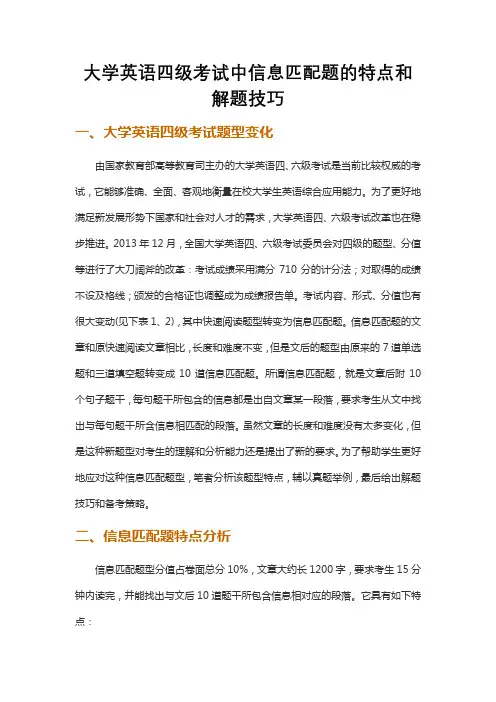
大学英语四级考试中信息匹配题的特点和解题技巧一、大学英语四级考试题型变化由国家教育部高等教育司主办的大学英语四、六级考试是当前比较权威的考试,它能够准确、全面、客观地衡量在校大学生英语综合应用能力。
为了更好地满足新发展形势下国家和社会对人才的需求,大学英语四、六级考试改革也在稳步推进。
2013年12月,全国大学英语四、六级考试委员会对四级的题型、分值等进行了大刀阔斧的改革:考试成绩采用满分710分的计分法;对取得的成绩不设及格线;颁发的合格证也调整成为成绩报告单。
考试内容、形式、分值也有很大变动(见下表1、2),其中快速阅读题型转变为信息匹配题。
信息匹配题的文章和原快速阅读文章相比,长度和难度不变,但是文后的题型由原来的7道单选题和三道填空题转变成10道信息匹配题。
所谓信息匹配题,就是文章后附10个句子题干,每句题干所包含的信息都是出自文章某一段落,要求考生从文中找出与每句题干所含信息相匹配的段落。
虽然文章的长度和难度没有太多变化,但是这种新题型对考生的理解和分析能力还是提出了新的要求。
为了帮助学生更好地应对这种信息匹配题型,笔者分析该题型特点,辅以真题举例,最后给出解题技巧和备考策略。
二、信息匹配题特点分析信息匹配题型分值占卷面总分10%,文章大约长1200字,要求考生15分钟内读完,并能找出与文后10道题干所包含信息相对应的段落。
它具有如下特点:表1 原大学英语四级考试题型1.题目无序信息匹配题打破了题文同序的原则,因此传统的从文章开头到结尾“逐一解题”的阅读技巧和解题思路在信息匹配题型中完全行不通。
考生要花费大量时间和脑力,通篇理解全文的前提下,才能把握文章主旨,从而正确定位。
2.一题可以两选四级考试中题干大于段落数,意味着有很多的干扰项,题目要求中也明确提醒说:“You may choose a paragraph more than once.”即有些段落可能对应两题,而另一些段落也许完全不被涉及。
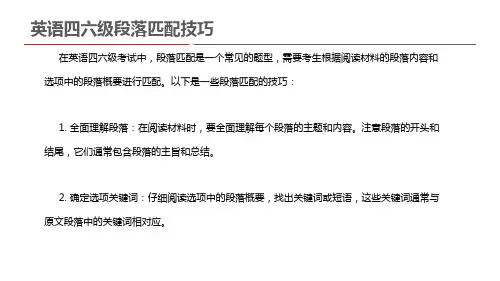
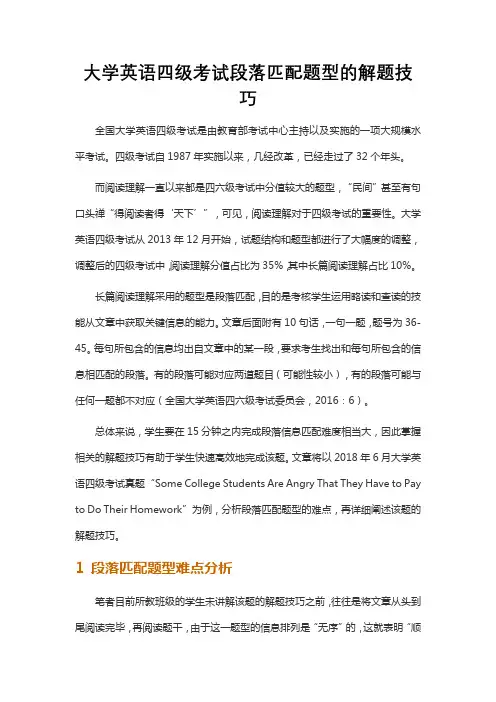
大学英语四级考试段落匹配题型的解题技巧全国大学英语四级考试是由教育部考试中心主持以及实施的一项大规模水平考试。
四级考试自1987年实施以来,几经改革,已经走过了32个年头。
而阅读理解一直以来都是四六级考试中分值较大的题型,“民间”甚至有句口头禅“得阅读者得‘天下’”,可见,阅读理解对于四级考试的重要性。
大学英语四级考试从2013年12月开始,试题结构和题型都进行了大幅度的调整,调整后的四级考试中,阅读理解分值占比为35%,其中长篇阅读理解占比10%。
长篇阅读理解采用的题型是段落匹配,目的是考核学生运用略读和查读的技能从文章中获取关键信息的能力。
文章后面附有10句话,一句一题,题号为36-45。
每句所包含的信息均出自文章中的某一段,要求考生找出和每句所包含的信息相匹配的段落。
有的段落可能对应两道题目(可能性较小),有的段落可能与任何一题都不对应(全国大学英语四六级考试委员会,2016:6)。
总体来说,学生要在15分钟之内完成段落信息匹配难度相当大,因此掌握相关的解题技巧有助于学生快速高效地完成该题。
文章将以2018年6月大学英语四级考试真题“Some College Students Are Angry That They Have to Pay to Do Their Homework”为例,分析段落匹配题型的难点,再详细阐述该题的解题技巧。
1 段落匹配题型难点分析笔者目前所教班级的学生未讲解该题的解题技巧之前,往往是将文章从头到尾阅读完毕,再阅读题干,由于这一题型的信息排列是“无序”的,这就表明“顺序解题”原则在此题型中并不适合。
而且毫无章法的将段落和题干信息匹配耗时长,正确率还相当低,尤其在第一段就是干扰段时,浪费的时间会更多。
未讲解解题技巧前,笔者班上学生该题的正确率大概在4-5道题左右。
2 段落匹配题型解题技巧2.1 改变做题思路做段落信息匹配题型,先要改变做题思路,我们需要做的是判断这一题干信息可能会出现在哪一段。

英语六级匹配题一、文章主旨匹配在匹配题中,文章主旨匹配是考察学生对文章整体内容的把握能力。
学生需要理解文章的主题,并从选项中找出与主题相关的内容。
在解题时,学生可以先快速浏览文章,了解文章的主题和结构,然后仔细分析每个选项,将其与文章内容进行对比,选出最符合文章主旨的选项。
二、细节信息匹配细节信息匹配是考察学生对文章中具体信息的掌握能力。
学生需要从文章中找出相关的细节信息,并与选项进行对比。
在解题时,学生可以先仔细阅读文章,找到相关的细节信息,然后分析每个选项,将其与细节信息进行对比,选出最符合细节信息的选项。
三、词汇匹配词汇匹配是考察学生对文章中特定词汇的理解和运用能力。
学生需要从文章中找出特定的词汇,并与选项进行对比。
在解题时,学生可以先仔细阅读文章,找到特定的词汇,然后分析每个选项,将其与特定词汇进行对比,选出最符合特定词汇的选项。
四、句子理解匹配句子理解匹配是考察学生对文章中特定句子的理解和运用能力。
学生需要从文章中找出特定的句子,并与选项进行对比。
在解题时,学生可以先仔细阅读文章,找到特定的句子,然后分析每个选项,将其与特定句子进行对比,选出最符合特定句子的选项。
五、段落理解匹配段落理解匹配是考察学生对文章中特定段落的把握和理解能力。
学生需要从文章中找出特定的段落,并与选项进行对比。
在解题时,学生可以先仔细阅读文章,找到特定的段落,然后分析每个选项,将其与特定段落进行对比,选出最符合特定段落的选项。
六、逻辑推理匹配逻辑推理匹配是考察学生对文章的逻辑关系和推理关系的把握和理解能力。
学生需要理解文章的逻辑关系和推理关系,并根据这些关系对选项进行判断。
在解题时,学生可以先仔细阅读文章,理解文章的逻辑关系和推理关系,然后分析每个选项,将其与文章的逻辑关系和推理关系进行对比,选出最符合这些关系的选项。
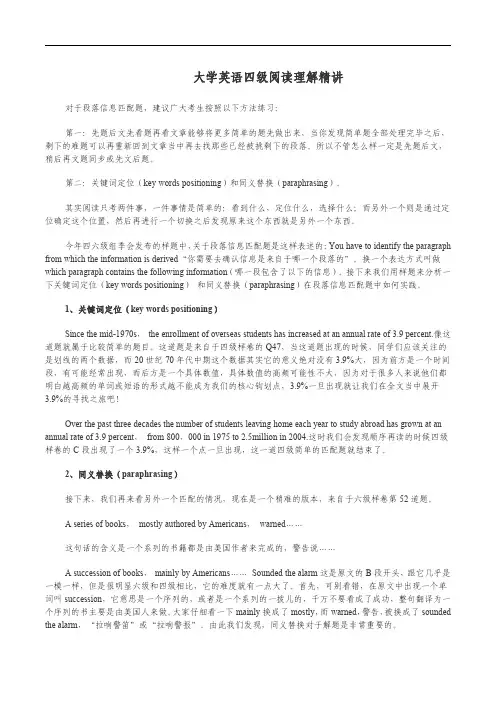
大学英语四级阅读理解精讲对于段落信息匹配题,建议广大考生按照以下方法练习:第一:先题后文先看题再看文章能够将更多简单的题先做出来,当你发现简单题全部处理完毕之后,剩下的难题可以再重新回到文章当中再去找那些已经被挑剩下的段落。
所以不管怎么样一定是先题后文,稍后再文题同步或先文后题。
第二:关键词定位(key words positioning)和同义替换(paraphrasing)。
其实阅读只考两件事,一件事情是简单的:看到什么,定位什么,选择什么;而另外一个则是通过定位确定这个位置,然后再进行一个切换之后发现原来这个东西就是另外一个东西。
今年四六级组季会发布的样题中,关于段落信息匹配题是这样表述的:You have to identify the paragraph from which the information is derived“你需要去确认信息是来自于哪一个段落的”。
换一个表达方式叫做which paragraph contains the following information(哪一段包含了以下的信息)。
接下来我们用样题来分析一下关键词定位(key words positioning)和同义替换(paraphrasing)在段落信息匹配题中如何实践。
1、关键词定位(key words positioning)Since the mid-1970s,the enrollment of overseas students has increased at an annual rate of3.9percent.像这道题就属于比较简单的题目。
这道题是来自于四级样卷的Q47,当这道题出现的时候,同学们应该关注的是划线的两个数据,而20世纪70年代中期这个数据其实它的意义绝对没有3.9%大,因为前方是一个时间段,有可能经常出现,而后方是一个具体数值,具体数值的高频可能性不大,因为对于很多人来说他们都明白越高频的单词或短语的形式越不能成为我们的核心钩划点,3.9%一旦出现就让我们在全文当中展开3.9%的寻找之旅吧!Over the past three decades the number of students leaving home each year to study abroad has grown at an annual rate of3.9percent,from800,000in1975to2.5million in2004.这时我们会发现顺序再读的时候四级样卷的C段出现了一个3.9%,这样一个点一旦出现,这一道四级简单的匹配题就结束了。
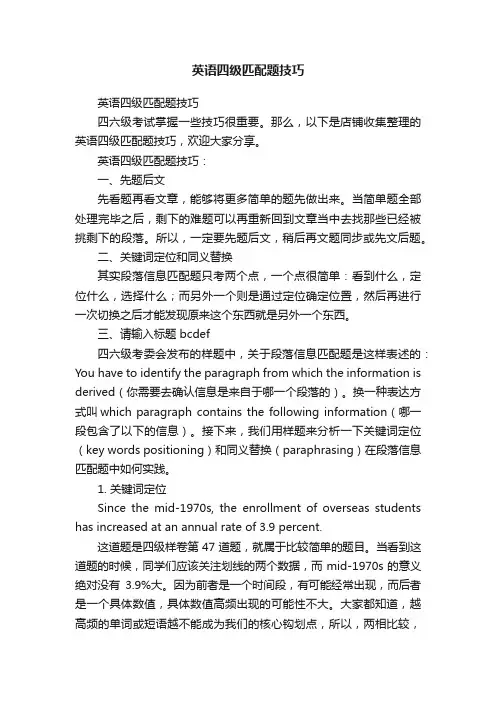
英语四级匹配题技巧英语四级匹配题技巧四六级考试掌握一些技巧很重要。
那么,以下是店铺收集整理的英语四级匹配题技巧,欢迎大家分享。
英语四级匹配题技巧:一、先题后文先看题再看文章,能够将更多简单的题先做出来。
当简单题全部处理完毕之后,剩下的难题可以再重新回到文章当中去找那些已经被挑剩下的段落。
所以,一定要先题后文,稍后再文题同步或先文后题。
二、关键词定位和同义替换其实段落信息匹配题只考两个点,一个点很简单:看到什么,定位什么,选择什么;而另外一个则是通过定位确定位置,然后再进行一次切换之后才能发现原来这个东西就是另外一个东西。
三、请输入标题 bcdef四六级考委会发布的样题中,关于段落信息匹配题是这样表述的:You have to identify the paragraph from which the information is derived(你需要去确认信息是来自于哪一个段落的)。
换一种表达方式叫which paragraph contains the following information(哪一段包含了以下的信息)。
接下来,我们用样题来分析一下关键词定位(key words positioning)和同义替换(paraphrasing)在段落信息匹配题中如何实践。
1. 关键词定位Since the mid-1970s, the enrollment of overseas students has increased at an annual rate of 3.9 percent.这道题是四级样卷第47道题,就属于比较简单的题目。
当看到这道题的时候,同学们应该关注划线的两个数据,而mid-1970s的意义绝对没有3.9%大。
因为前者是一个时间段,有可能经常出现,而后者是一个具体数值,具体数值高频出现的可能性不大。
大家都知道,越高频的单词或短语越不能成为我们的核心钩划点,所以,两相比较,要把3.9%作为定位关键词。
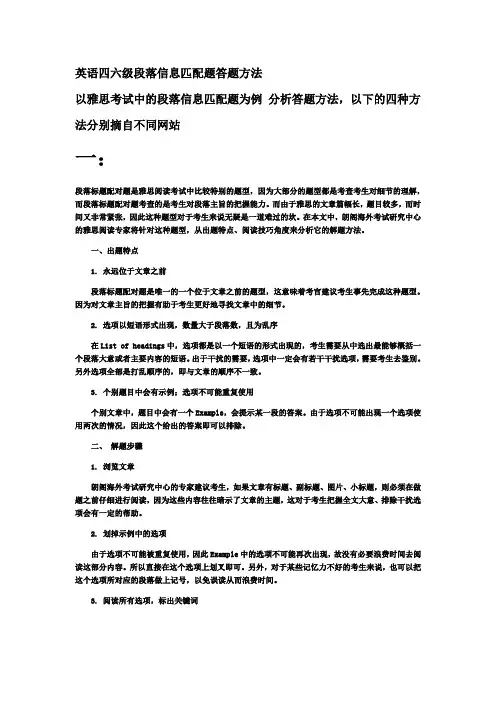
英语四六级段落信息匹配题答题方法以雅思考试中的段落信息匹配题为例分析答题方法,以下的四种方法分别摘自不同网站一:段落标题配对题是雅思阅读考试中比较特别的题型,因为大部分的题型都是考查考生对细节的理解,而段落标题配对题考查的是考生对段落主旨的把握能力。
而由于雅思的文章篇幅长,题目较多,而时间又非常紧张,因此这种题型对于考生来说无疑是一道难过的坎。
在本文中,朗阁海外考试研究中心的雅思阅读专家将针对这种题型,从出题特点、阅读技巧角度来分析它的解题方法。
一、出题特点1. 永远位于文章之前段落标题配对题是唯一的一个位于文章之前的题型,这意味着考官建议考生事先完成这种题型。
因为对文章主旨的把握有助于考生更好地寻找文章中的细节。
2. 选项以短语形式出现,数量大于段落数,且为乱序在List of headings中,选项都是以一个短语的形式出现的,考生需要从中选出最能够概括一个段落大意或者主要内容的短语。
出于干扰的需要,选项中一定会有若干干扰选项,需要考生去鉴别。
另外选项全部是打乱顺序的,即与文章的顺序不一致。
3. 个别题目中会有示例;选项不可能重复使用个别文章中,题目中会有一个Example,会提示某一段的答案。
由于选项不可能出现一个选项使用两次的情况,因此这个给出的答案即可以排除。
二、解题步骤1. 浏览文章朗阁海外考试研究中心的专家建议考生,如果文章有标题、副标题、图片、小标题,则必须在做题之前仔细进行阅读,因为这些内容往往暗示了文章的主题,这对于考生把握全文大意、排除干扰选项会有一定的帮助。
2. 划掉示例中的选项由于选项不可能被重复使用,因此Example中的选项不可能再次出现,故没有必要浪费时间去阅读这部分内容。
所以直接在这个选项上划叉即可。
另外,对于某些记忆力不好的考生来说,也可以把这个选项所对应的段落做上记号,以免误读从而浪费时间。
3. 阅读所有选项,标出关键词由于选项是乱序,因此如果先读文章再去找选项,就有可能出现每读一个段落,就要通读一遍所有的选项这样的问题,最后发现把所有的选项读了数遍。
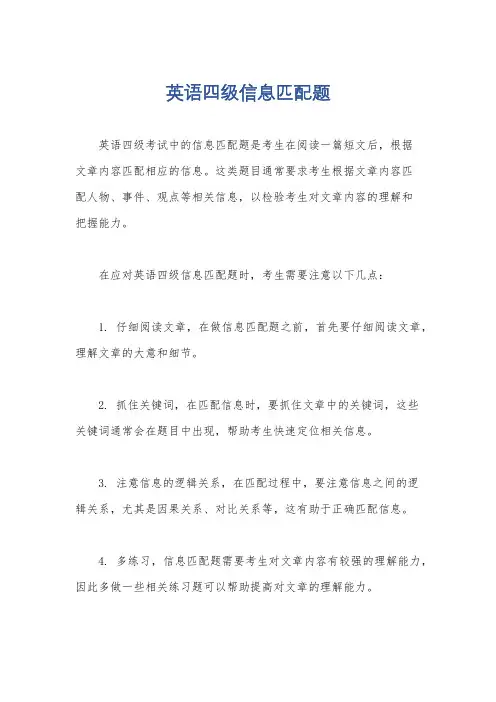
英语四级信息匹配题
英语四级考试中的信息匹配题是考生在阅读一篇短文后,根据
文章内容匹配相应的信息。
这类题目通常要求考生根据文章内容匹
配人物、事件、观点等相关信息,以检验考生对文章内容的理解和
把握能力。
在应对英语四级信息匹配题时,考生需要注意以下几点:
1. 仔细阅读文章,在做信息匹配题之前,首先要仔细阅读文章,理解文章的大意和细节。
2. 抓住关键词,在匹配信息时,要抓住文章中的关键词,这些
关键词通常会在题目中出现,帮助考生快速定位相关信息。
3. 注意信息的逻辑关系,在匹配过程中,要注意信息之间的逻
辑关系,尤其是因果关系、对比关系等,这有助于正确匹配信息。
4. 多练习,信息匹配题需要考生对文章内容有较强的理解能力,因此多做一些相关练习题可以帮助提高对文章的理解能力。
5. 注意答题顺序,在答题时可以根据自己的理解和把握情况选
择合适的答题顺序,有时候先做容易的题目可以增加信心和积极性。
总的来说,应对英语四级信息匹配题,考生需要在平时多加练习,提高对文章内容的理解能力,同时在考试时要保持冷静,仔细
阅读题目和文章,有条不紊地进行信息匹配,以确保准确无误地完
成题目。
希望这些建议对你有所帮助。
英语六级abcd答案规律ABCD分布均匀。
一,六级答案法则也就是:20篇阅读理解,ABCD基本是个5,近几年却出现4664分布,仅有一次出现8 D一般情况下,不可能有3个相同的答案,比如:AAA,通常会有问题。
词汇量为ABCD7887,最高可达9题。
在10 C的情况下很可能会出问题。
这条规则只能用于检验,而不能用于做题。
听问题,前十个听不到的就不要选,后十个听人选的。
选择规则:对话中提到的事情总是朝着坏的方面发展。
比如在对话会上问教授的课一定很难;男人给出的邀请,女她从来不会答应;总是一个男生首先发出邀请,每次邀请都是Mary,有两种意义相反的选举项,则必然有一个是答案。
在短文中反复出现的词或词组很大可能就是答案,所听即所得。
此外,考前做一套听力题热热身也是非常必要的,一定会磨耳朵哦。
二、选词填空蒙题技巧:选择填空题一般称15选10,但许多人在此因不认识单词或文章未读懂。
误差通常超过一半。
选择填空的规律可以归纳为一句话:根据挖空句,选择符合词性含义的词。
就拿2018年6月第一次真题来说,在15个选项中名词7、动词7、形容词3、副词2个。
为什么会有更多的呢?那是因为有些词具有多种词性,尽管占的比例并不太大。
本文主要介绍以下几个方面:分析在挖空前是什么,挖空后是什么,挖空处缺什么词。
三、段落匹配题小技巧:从句中提取人名、地名、事件。
基本上就是寻找名词。
回答将与原来的不一样,基本上是同义替换。
四、阅读理解题蒙题技巧:过去我们常听到这样一句话:“四、六级地读懂者得天下”,这句话的确不假。
读写通常遵循以下规则。
朗读十题:最后的答案模式是:2 ABCD+ A/B/C/D中任意两个。
我们来看2018年6月的第一组真题,前五题答案是:CDCBA,后五个答案是:ADCBD。
在阅读理解中,最难的可能是数数细节题,这类题目我们怎么做?在选择时要记住照抄或似乎照抄原文并不普遍。
赞成变换的就是正确的答案;选择中太多绝对不是答案,非常肯定语气词的选择才是正确答案。
英语四六级段落信息匹配题一、英语四六级段落信息匹配题是什么?原快速阅读理解调整为长篇阅读理解,篇章长度和难度不变。
篇章后附有10个句子,每句一题。
每句所含的信息出自篇章的某一段落,要求考生找出与每句所含信息相匹配的段落。
有的段落可能对应两题,有的段落可能不对应任何一题。
四级考试需要各位同学做的是,大家需要去看十个左右的段落,然后去匹配十个信息点。
但是到六级当中,我们的难度就要增加了,我们见到的情况是六级当中变成了15个段落,去匹配十个信息点。
但总体来看,不管题型怎么变,其实学习方法没变,还是仍旧需要大家提高阅读的能力,比如说读文章的时候,是不是直接拿英语读,如果读快速阅读的时候,还是拿中文边翻译边读的话,会发现阅读速度一直会比较慢,所以那么长的文章很难找到细节,所以大家一定要养成拿英语直接阅读的这样一种习惯,这样才能保证我们的阅读真正速度又快又准。
二、样题:Universities Branch OutA) As never before in their long history, universities have become instruments of national competition as well as instruments of peace. They are the place of the scientific discoveries that move economies forward, and the primary means of educating the talent required to obtain and maintain competitive advantage. But at the same time, the opening of national borders to the flow of goods, services, information and especially people has made universities a powerful force for global integration, mutual understanding and geopolitical stability.B) In response to the same forces that have driven the world economy, universities have become more self-consciously global: seeking students from around the world who represent the entire range of cultures and values, sending their own students abroad to prepare them for global careers, offering courses of study that address the challenges of an interconnected world and collaborative (合作的) research programs to advance science for the benefit of all humanity.C) Of the forces shaping higher education none is more sweeping than the movement across borders. Over the past three decades the number of students leaving home each year to study abroad has grown at an annual rate of 3.9 percent, from 800,000 in 1975 to 2.5 million in 2004. Most travel from one developed nation to another, but the flow from developing to developed countries is growing rapidly. The reverse flow, from developed to developing countries, is on the rise, too. Today foreign students earn 30 percent of the doctoral degrees awarded in the United States and 38 percent of those in the United Kingdom. And the number crossing borders for undergraduate study is growing as well, to 8 percent of the undergraduates at America’s best institutions and 10 percent of all undergraduates in the U.K. In the United States, 20 percent of the newly hired professors in science and engineering are foreign-born, and in China many newly hired faculty members at the top research universities received their graduate education abroad.D) Universities are also encouraging students to spend some of their undergraduate years in another country. In Europe, more than 140,000 students participate in the Erasmus program each year, taking courses for credit in one of 2,200 participating institutions across the continent. And in the United States, institutions are helping place students in summer internships (实习) abroad to prepare them for global careers. Yale and Harvard have led the way, offering every undergraduate at least one international study or internship opportunity—and providing the financial resources to make it possible.E) Globalization is also reshaping the way research is done. One new trend involves sourcing portions of a research program to another country. Yale professor and Howard Hughes Medical Institute investigator Tian Xu directs a research center focused on th e genetics of human disease at Shanghai’s Fudan University, in collaboration with faculty colleagues from both schools. The Shanghai center has 95 employees and graduate students working in a 4,300-square-meter laboratory facility. Yale faculty postdoctors and graduate students visit regularly and attend videoconference seminars with scientistsfrom both campuses. The arrangement benefits both countries; Xu’s Yale lab is more productive, thanks to the lower costs of conducting research in China, and Chinese graduate students, postdoctors and faculty get on-the-job training from a world-class scientist and his U.S. team.F) As a result of its strength in science, the United States has consistently led the world in the commercialization of major new technologies, from the mainframe computer and the integrated circuit of the 1960s to the Internet infrastructure (基础设施) and applications software of the 1990s. The link between university-based science and industrial application is often indirect but sometimes highly visible: Silicon Valley was intentionally created by Stanford University, and Route 128 outside Boston has long housed companies spun off from MIT and Harvard. Around the world, governments have encouraged copying of this model, perhaps most successfully in Cambridge, England, where Microsoft and scores of other leading software and biotechnology companies have set up shop around the university.G) For all its success, the United States remains deeply hesitant about sustaining the research-university model. Most politicians recognize the link between investment in science and national economic strength, but support for research funding has been unsteady. The budget of the National Institutes of Health doubled between 1998 and 2003, but has risen more slowly than inflation since then. Support for the physical sciences and engineering barely kept pace with inflation during that same period. The attempt to make up lost ground is welcome, but the nation would be better served by steady, predictable increases in science funding at the rate of long-term GDP growth, which is on the order of inflation plus 3 percent per year.H) American politicians have great difficulty recognizing that admitting more foreign students can greatly promote the national interest by increasing international understanding. Adjusted for inflation, public funding for international exchanges and foreign-language study is well below the levels of 40 years ago. In the wake of September 11, changes in the visa process caused a dramatic decline in the number of foreign students seeking admission to U.S. universities, and a corresponding surge in enrollments in Australia, Singapore and the U.K. Objections from American university and business leaders led to improvements in the process and a reversal of the decline, but the United States is still seen by many as unwelcoming to international students.I) Most Americans recognize that universities contribute to the nation’s well-being through their scientific research, but many fear that foreign students threaten American competitiveness by taking their knowledge and skills back home. They fail to grasp that welcoming foreign students to the United States has two important positive effects: first, the very best of them stay in the States and—like immigrants throughout history—strengthen the nation; and second, foreign students who study in the United States become ambassadors for many of its most cherished (珍视) values when they return home. Or at least they understand them better. In America as elsewhere, few instruments of foreign policy are as effective in promoting peace and stability as welcoming international university students.注意:此部分试题请在答题卡 2 上作答。